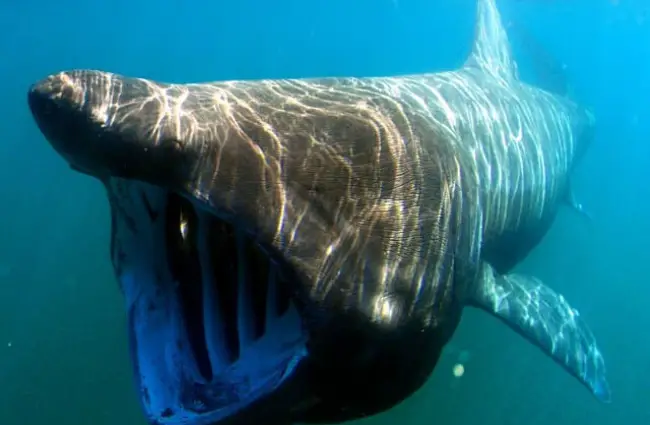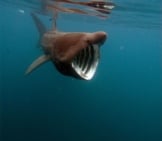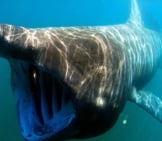The basking shark is the second largest living fish in the world, and is one of three plankton-eating sharks known to mankind today. The basking shark feeds through the massive gill slits that encircle its head, which filter large amounts of water for plankton. With a pointed snout, and moon-shaped tail, the basking shark is one of the most distinctive looking sharks on the planet. Read on to learn about the basking shark.
Description of the Basking Shark
The basking shark is the second largest fish in the sea, reaching a maximum size of at least 33 feet (10 meters) in length. This gentle giant has five large gill slits that circle its head, through which plankton flows and is filtered for feeding. Each gill contains thousands of gill rakers to collect its meal.
The body of the basking shark is extremely unique, with a crescent moon-shaped tail, pointed snout, and fins that can reach almost two meters in length. The basking shark’s body is a grey-brown color that can be pale on the underbelly. The shark’s mouth can open to about 3 feet wide (1 meter), and contains more teeth than any other shark; though these teeth are small, and hooked in shape.
Interesting Facts about the Basking Shark
The basking shark gets its name from the way it feeds, floating to the water’s surface with the dorsal fin (the fin located along the fish’s back) sticking out of the water and basking in the sun’s rays. Due to its distinct appearance, the basking shark has been given a number of nicknames including: “elephant shark,” “bone shark,” and “sun-fish.” Little is known about the basking shark, but what we do know is that the basking shark is unlike any other shark found in the sea.
- Large Liver – The basking shark’s liver is so large that is makes up 25% of its total body weight, and actually provides buoyancy (ability to float) in the water.
- Changing Snout – Juvenile basking sharks have a hook-like snout that changes shape after they reach one year of age.
- Many Teeth – The basking shark has more teeth than any other species of shark on Earth.
Habitat of the Basking Shark
The basking shark is a coastal species, found throughout the world in artic waters, as well as more temperate regions. This might be why these sharks are typically seen at the water’s surface, basking in the sun.
Distribution of the Basking Shark
The basking shark can be found throughout the world, though always close to the shoreline. From frigid waters, to relatively warm waters, this shark has a migrating nature. The basking shark resides in the Western Atlantic and Western Pacific oceans, the Gulf of Alaska, and the Gulf of California (Sea of Cortez). The Basking shark can be found off the coasts of the following countries:
- Argentina
- Chile
- China
- Eastern Pacific
- Ecuador
- Florida
- Iceland
- Japan
- Korea
- Mediterranean Sea
- New Zealand
- Newfoundland
- Norway
- Senegal
- Southern Australia
- Southern Brazil
Diet of the Basking Shark
The basking shark feeds on plankton, using a special technique to feed known as “passive feeding.” This means that the basking shark can simply swim through the water with its mouth open, and the plankton will become trapped in the gill rakers as the water passes over the gills. One of these large fish can filter roughly 2,000 tons of water per hour, which helps the shark to feast quickly as the giant fish drifts through the water.
Basking Shark and Human Interaction
Basking sharks are passive animals that are not known to be a threat to humans. However, basking sharks are very large creatures with tough skin that may be dangerous if threatened, so caution is advised. The basking shark was once hunted around the world for its vitamin rich liver, fins, meat, and oil. Today, however, hunting of the gentle giant has been made illegal in all countries except Japan and China. The liver is sold as an aphrodisiac and health food in Japan, whereas the oil is used as an ingredient in cosmetics.
Domestication
The basking shark is not a domesticated fish, but is relatively tolerant of boats and divers.
Does the Basking Shark Make a Good Pet
The basking shark would not make a good pet, as its sheer size would make it impossible to keep at home. Also, the basking shark’s skin has “dermal denticles,” which are tooth-like scales that point in all directions. Contact with these can cause some pretty nasty cuts and scratches.
Basking Shark Care
The basking shark is not kept in captivity, but is protected in its natural habitat by the British Government, the U.S. Departments of Commerce and Interior, as well as the Food and Agricultural Organization of the United Nations.
Behavior of the Basking Shark
We know very little about the basking shark’s behavior, as the shark mysteriously disappears from its home in the coastal waters. Scientists believe that this behavior is a type of hibernation, as the basking shark only seems to disappear during the months of winter.
Although believed to be creatures of solitude, the basking shark has been found in pairs, and occasionally in large schools of nearly 100 fish. The basking shark has been known to leap out of the water, into the air, which experts believe to be part of their behavioral interactions, but no evidence as to why these fish jump from the water has been found.
Reproduction of the Basking Shark
The basking shark is believed to be ovoviviparous, meaning the eggs develop and actually hatch while inside the mother. The newly born young then feed on the yolk sac inside the egg from which they were hatched, before leaving the protection of the mother’s body. The only basking shark that was ever caught giving birth, gave birth to six live young. The basking shark is believed to reproduce every 2-4 years.
Beliefs, Superstitions, and Phobias about the Basking Shark
Many ancient tales of sea serpents, and monsters of the sea, where actually based on sightings of the basking shark. Fishermen who caught glimpses of the grant fish could not believe the creature to be a fish, due to its rare physical appearance. They then reported having seen a large beast inhabiting the ocean.

















![Red Angus Closeup of a beautiful Red Angus cowPhoto by: U.S. Department of Agriculture [pubic domain]https://creativecommons.org/licenses/by/2.0/](https://animals.net/wp-content/uploads/2020/03/Red-Angus-4-100x75.jpg)

